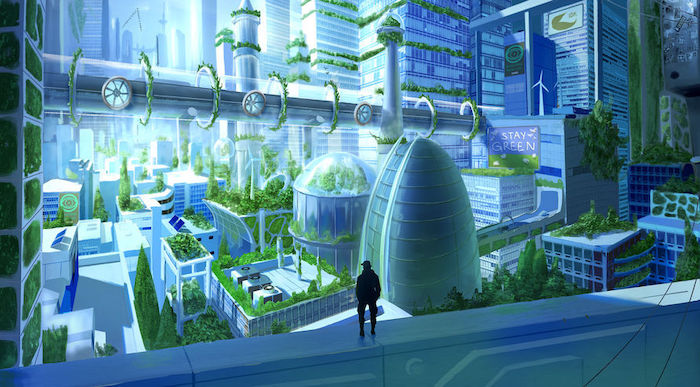VISUAL PROMPT
by Ricarda Wegmann @ deviantart.com/yumenoki

Write a story set in an eco-friendly future.
The Final Forest
Twelve hours of travel and Jazzie’s view outside the holo window of her AirTram looked much the same as when she set out early this morning. Tall, silvery domed skyscrapers stretched out for miles, past the horizon. Patches of green spread out among them (100 by 100 foot squares, as regulated by society ordinance) filled with all kinds of crops: corn, wheat, lentils, various orchards, vineyards. She had traveled through what we would call Colombia, Guatemala, Texas, Arizona—and it all looked exactly the same. Skyscrapers alternating with lush fields.
Agricultural discoveries from centuries ago had made it possible to regulate microenvironments on any part of the earth, so that any type of plant could be grown and harvested anywhere. People began settling in deserts, tundras, rainforests, even on top of oceans. All areas that were previously inhabitable became habitable.
It changed everything.
Population boomed from 9 billion to 346 billion and counting over the next few centuries. Society adopted a one world government, currency, and language. Aside from a few key historical sights (like the pyramids), people tore down their homes and opted to live in uniform, bioefficient skyscrapers. In these buildings, new technology allowed human waste to be converted to fertilizer that supplied the fields at a 98.2% efficiency rate, and you were paid for your waste services in the amount of food produced by said waste. Poverty was eliminated. People spent their time as they pleased. It was a utopia of discovery and innovation like none other.
But, as you’ve realized already, dear reader; efficiency doesn’t eliminate the world’s problems.
It certainly didn’t eliminate Jazzie’s problems.
In fact, all that Jazzie wanted was to run away from the world. She was an agricultural waste profitability scientist, which is a fancy name for someone who tests excrement and runs analyses on ways to make it the most efficient. She spent her days pondering questions like, if a person’s diet consists of 32.5% lentils, 16.8% soy protein, 37.6% fermented cabbage, and 13.1% of raw vegetable matter, would their excrement yield a more favorable growth outcome to the wheat fields than a person’s diet consisting of the same, but with a 1% variation in soy protein consumption?
It was all very tedious, very boring, and very stinky.
Twenty-six years old and she felt she had only ever seen the inside of a lab. She had done what society and her parental figures demanded of her—studied hard, placed well on exams, overachieved in a respectable number of classes and extracurricular activities. She pursued botanical science because plants absolutely fascinated her, even from a young age. Each household was allotted one houseplant that wasn’t a part of the bio fields, and her family always chose a spider plant, which would make little spider plants of its own every couple months. These, of course, needed destroyed since they exceeded the single houseplant allotment, but its natural propagation took root in Jazzie’s mind. Did other plants grow like these?
Propagation in the fields was entirely automated, down to a 0.1% growth variation from parent to daughter specimens. What began in labs continued worldwide in those tightly regulated microenvironments, except in one part of the world, in what used to be California, a place once called Yosemite National Park. Here, supposedly hundreds of acres existed with no skyscrapers and no regulation—only wild creatures, natural rain, and ancient trees.
Ancient trees. Redwoods, thousands of years old. The trees found in your typical orchard only reached 20 some years at their eldest before they were destroyed (their yield decreased too much as they got older, and you can’t have inefficient trees taking up space). Jazzie was determined to study these trees and learn why society held onto them, even though they didn’t produce anything consumable for humans. She saved up for years to visit the park, lobbying for grants to perform her studies.
Suddenly, the park shut down. Permanently.
Why? No one could answer Jazzie’s question. So, like any overachieving, curious soul such as herself, she decided to take all her savings and trek the 1000 miles to find out with her own eyes.
The day she announced as much, she was fired.
